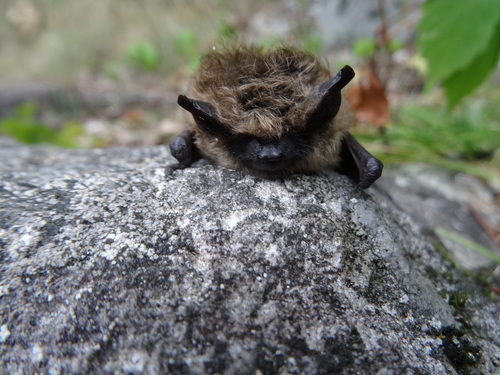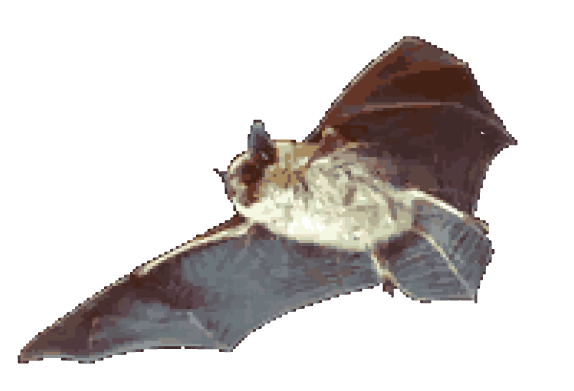Eastern Small-footed Myotis

Species information
The following is a report on progress made towards the protection and recovery of Eastern Small-footed Myotis (Myotis leibii) in Ontario from 2007 to 2022, based on Ontario’s species-specific recovery policy. This report meets the legislative requirement for a review of progress under the Endangered Species Act, 2007 (ESA or “the Act”). Eastern Small-footed Myotis is listed as endangered on the Species at Risk in Ontario (SARO) List under the ESA.
Eastern Small-footed Myotis was listed as an endangered species under the ESA on June 27, 2014.
Eastern Small-footed Myotis has been protected from being killed, harmed, harassed, captured or taken since 2014.
In addition, the habitat of Eastern Small-footed Myotis has been protected from being damaged or destroyed since 2014.
The species-specific recovery policy for Eastern Small-footed Myotis, known as the Government Response Statement (GRS) was published in 2018 and includes the government’s recovery goal for the species and the actions and priorities it intends to lead or support to help achieve that goal. The GRS considers science advice provided in the recovery strategy (published in 2017), such as species biology, habitat needs, threats to survival, knowledge gaps and approaches to recovery, when developing recovery actions for the species. As legislated in the Act, the purpose of this Review is to report on progress made towards implementing the protection and recovery actions in the GRS. The review can also help identify opportunities to adjust and adapt the implementation of protection and recovery actions to achieve the recovery goal for the species.
2014 Listed as Endangered
2014 Species Protected
2014 Habitat Protected through the general definition of habitat under the ESA since 2014.
2017 Recovery Strategy finalized
2018 Government Response Statement finalized
2023 Review of Progress finalized
Further information about Eastern Small-footed Myotis, including the threats that it faces, and actions being taken to help protect and recover this species is available on the Government of Ontario webpage for Eastern Small-footed Myotis. A summary on the progress towards the protection and recovery of Eastern Small-footed Myotis and an annual update on the broader species at risk program (i.e. the Introduction to the 2023 Review of Progress report) is available on the Review of Progress towards the Protection and Recovery of Ontario’s Species at Risk webpage.
Snapshot: Progress towards the protection and recovery of Eastern Small-footed Myotis
Progress towards meeting the recovery goal
- The recovery goal in the Government Response Statement (GRS) for Eastern Small-footed Myotis in Ontario is to “maintain the persistence of the species at existing locations in Ontario while filling knowledge gaps related to the species’ biology, habitat requirements, and the presence and severity of threats.” In the long-term, the government’s goal is to “support a self-sustaining Eastern Small-footed Myotis provincial population throughout its current range.”
- Progress has been made towards implementing all of the government-led actions. Progress has been made towards implementing all of the government-supported recovery objectives and all of the associated actions. Examples of progress include:
- Identifying, surveying, and monitoring roosting and maternity sites for Eastern Small-footed Myotis at varying scales
- Filling knowledge gaps on seasonal distribution and roost selection of Eastern Small-footed Myotis through acoustic monitoring and roost exit surveys
- Investigating the effects of White-Nose Syndrome (WNS) on Eastern Small-footed Myotis survival
- In alignment with the GRS, further work is required to:
- Maintain and update WNS decontamination protocols, coordinate national-level WNS monitoring, and identify related data gaps and data management needs
- Collaborate with other organizations to evaluate and where appropriate implement monitoring to assess the potential impacts of WNS at hibernacula, and determine the feasibility of implementing monitoring to assess impacts of the disease at summer roost sites for Eastern Small-footed Myotis
Occurrences and distribution:
- Forty populations of Eastern Small-footed Myotis have been documented in several locations across Ontario, especially Southern Ontario. Currently, 26 of these populations are extant, whereas the remaining 14 are considered historical.
- Twenty-one populations of Eastern Small-Footed Myotis have been newly-identified since 2008, while five populations were reconfirmed as extant.
- Since 2014, the Natural Heritage Information Centre (NHIC) has received 128 records of the species based on observations made between 1949 and 2022.
Government-supported stewardship projects:
- Through the Species at Risk Stewardship Program, the Government of Ontario has supported 21 projects (by providing $1,358,569 in funding) designed to contribute to the protection and recovery of multiple species at risk, including Eastern Small-footed Myotis. Twenty of these projects were designed to provide benefits to multiple species at risk (e.g., landscape-level habitat restoration, or outreach and education focusing on a certain group of species such as those present in a local region), while one project focused exclusively on Eastern Small-footed Myotis.
- The government’s support helped its stewardship partners to involve 849 individuals who volunteered 12,038 hours of their time towards protection and recovery activities for species at risk, including Eastern Small-footed Myotis. The estimated value of these voluntary contributions, as well as additional funding and in-kind support, is $1,778,869.
- Stewardship partners reported that through their actions approximately 117 hectares of habitat were enhanced for Eastern Small-footed Myotis and other species at risk that inhabit the same ecosystem.
- Stewardship partners reported providing outreach on multiple species at risk, including Eastern Small-footed Myotis, to 2,847,440 individuals.
Supporting human activities while ensuring appropriate support for species recovery:
- The Government of Ontario has issued nineteen permits for this species: Two ‘human health or safety’ permits were issued under clause 17(2)(a), six ‘protection or recovery’ permits were issued under clause 17(2)(b), six ‘overall benefit’ permits were issued under clause 17(2)(c), and five ‘social or economic benefit’ permits were issued under clause 17(2)(d) of the ESA.
- One-hundred and twenty activities have been registered for the species. The activities were registered under ‘drainage works’ (section 23.9), ‘ecosystem protection’ (section 23.11), ‘transition – development ongoing when species first listed, etc.’ (section 23.13), ‘pits and quarries’ (section 23.14), ‘possession for educational purposes, etc.’ (section 23.15), ‘species protection, recovery activities’ (section 23.17), ‘threats to health and safety, not imminent’ (section 23.18), and ‘wind facilities’ (section 23.20) under Ontario Regulation 242/08 of the ESA.
Reporting on the progress towards the protection and recovery of Eastern Small-footed Myotis
Recovery Goal
The government’s goal for the recovery of Eastern Small-footed Myotis is to maintain the persistence of the species at existing locations in Ontario while filling knowledge gaps related to the species’ biology, habitat requirements, and the presence and severity of threats.
The long-term goal is to support a self-sustaining Eastern Small-footed Myotis provincial population throughout its current range.
The implementation of government-led and government-supported actions demonstrates progress towards reaching the desired objectives and the recovery goal set out in the GRS.
Progress towards implementing government-led actions
Progress has been made towards implementing all the government-led actions identified in the GRS. Common actions for the government to lead as it works towards achieving a species’ recovery goal include:
- Educate other agencies and authorities involved in planning and environmental assessment processes on the protection requirements under the ESA.
- Encourage the submission of Eastern Small-footed Myotis data to the Ministry’s central repository at the Natural Heritage Information Centre.
- Undertake communications and outreach to increase public awareness of species at risk in Ontario.
- Continue to protect Eastern Small-footed Myotis and its habitat through the ESA.
- Support conservation, agency, municipal and industry partners, and Indigenous communities and organizations to undertake activities to protect and recover Eastern Small-footed Myotis. Support will be provided where appropriate through funding, agreements, permits (including conditions) and/or advisory services.
- Encourage collaboration, and establish and communicate annual priority actions for government support in order to reduce duplication of efforts.
Additionally, the government has directly undertaken the following species-specific actions:
- Continue to implement Ontario’s White-nose Syndrome Response Plan to address the threat of Pseudogymnoascus destructans on Eastern Small-footed Myotis, and coordinate WNS prevention, surveillance and monitoring efforts with other provincial, national and international plans including the Canadian Health Wildlife Cooperative’s (CWHC) National Wildlife Disease Database, North American Bat Monitoring Program, and national WNS Working Groups.
- Coordinate Ontario-based Eastern Small-footed Myotis research and monitoring, including government-supported efforts undertaken by partners, and integrate with national and international efforts (e.g., North American Bat Monitoring Program).
- Evaluate the effectiveness of existing bat survey protocols for Eastern Small-footed Myotis. Based on this evaluation and if necessary, develop a protocol to be used by proponents and partners to survey for the presence or absence of Eastern Small-footed Myotis.
- Continue to conduct research and population monitoring for Eastern Small-footed Myotis at known hibernacula, identify potential roost sites and swarming sites, monitor maternity roosts, and increase understanding of habitat use for different life stages.
- Apply multiple methods (including genetics, mark-recapture surveys and trend analysis) to estimate Eastern Small-footed Myotis population size, trends over time, and response to WNS.
- Continue to contribute to Bird Studies Canada’s Wind Energy Bird and Bat Monitoring Database to improve understanding of negative effects of wind power on bats.
- Continue to undertake outreach and collaborate with stakeholders in the mining industry and groups using caves to increase awareness and reduce impacts of activities on Eastern Small-footed Myotis, and prevent the spread of WNS.
Key progress made towards implementing these actions is described in the following sections.
Ontario’s White-nose Syndrome Response Plan
The Ministry of Natural Resources and Forestry (MNRF) continues to implement Ontario’s White-nose Syndrome Response Plan to monitor the threat of the Pseudogymnoascus destructans fungus to bat populations. A funded partnership with the Canadian Wildlife Health Cooperative (CWHC) provides White-nose syndrome (WNS) surveillance and monitoring. The 2022 CWHC Annual National Bat Health Report states necropsies were performed on 349 deceased bat specimens, which were collected and provided by provincial, territorial, federal, and other partners. Cause of death was determined for 194 specimens; trauma, primarily caused by cat predation, was the most common cause of death (33.5%) while white-nose syndrome accounted for 2.1% of deaths. The CWHC concluded that WNS in this year’s sample was relatively uncommon but “remains important to be vigilant for.” The CWHC partnership also provides a host of tools and information to support prevention and mitigation as well as management and response, which are available online at the CWHC website. In addition, Ontario provides public messaging about White-nose Syndrome via Ontario.ca.
In particular, the Ministry of Natural Resources and Forestry’s Wildlife Research and Monitoring Section (WRMS) continues to implement Ontario’s WNS Response Plan for Eastern Small-footed Myotis. At two maternity roosts in Southwestern Ontario, WRMS has been collecting data on survivorship and reproductive success using a variety of methods, including pre-volant (period before bat pups can fly) and post-volant (period when bat pups start to fly) exit counts and the capture and marking of individuals. WRMS has also been monitoring for any wing damage and skin anomalies caused by past WNS infection in captured adult female Eastern Small-footed Myotis. Similarly, numbers of Eastern Small-footed Myotis, as well as other species at risk (SAR) bats, have been monitored at an important swarming/hibernaculum site close to these maternity roosts. Captured individuals are sexed, banded, and assessed for WNS damage prior to release.
Bat acoustic data from 15 locations along the Southern Niagara Escarpment and Lake Erie shoreline were collected in 2021 and 2022 following North American Bat (NABat) survey protocols. Eastern Small-footed Myotis recordings were obtained at some of these sites. These data will be provided to the NABat monitoring program once analysis has been completed. By doing so, WRMS is progressing the government-led action of coordinating Ontario-based Eastern Small-footed Myotis research and monitoring by integrating with national and international efforts through partners such as the NABat monitoring program.
Research on Maternity Habitat for Eastern Small-footed Myotis
Using multiple techniques, the province has performed research on Ontario maternity habitat for Eastern Small-footed Myotis, which is helping to inform assessment and development of SAR bat survey protocols. Bat surveys may help determine species presence and use of rock and crevice habitat for roosting, narrow the timing window for when Eastern Small-footed Myotis are in hibernation, and support advice on the timing of work in these habitats. WRMS provides data and information to partners such as Conservation Authorities, universities, and Indigenous groups, to support local bat monitoring and conservation efforts.
Research, Population Monitoring, and Habitat Use
WRMS has continued monitoring Eastern Small-footed Myotis maternity roosts in 2021 and 2022, developing a more complete picture of bat numbers and activity levels through the maternity season. These efforts have resulted in evidence of female inter-annual site fidelity (the tendency for females to return to the same site each year) and natal philopatry (young returning to or remaining in the territory they were born), as well as evidence that females first arrive back at the maternity roosts very early (in late March) and will return periodically after swarming up until the end of November. Males have been found to remain at swarming/hibernation sites into June. Research has also been undertaken to compare anthropogenic (artificially created) and natural rock roosts of Eastern Small-footed Myotis. This information can be used to inform determination of timing windows for permitted activities that may affect roost habitats.
WRMS has also been banding, tagging, and tracking adults and juveniles at two maternity roosts since 2016, and periodically at an important swarming site since 2018. This information can be used to track trends over time for these local Southern Ontario populations. Additional coverage in other parts of the province could be used to estimate trends for Eastern Small-footed Myotis at the provincial scale.
Finally, to support longer-term genetic research on bats, WRMS has put together a gene bank of tail membrane and guano (excrement) samples, gathered from material from a few hundred individual Eastern Small-footed Myotis from roosts and hibernacula across Ontario.
Occurrences and distribution
Forty populations
Since 2008, 21 new populations have been identified. Five populations that were identified in 2008 were reconfirmed as extant in 2023. The newly identified local populations are likely the result of increased search effort and education about Eastern Small-footed Myotis and may not represent actual population increases, but rather increased knowledge about the distribution of the species.
It is possible that there are observations of Eastern Small-footed Myotis that have not been submitted to the government. Encouraging the submission of observations of this species is included in the GRS as a government-led action. Submission of species observations increases our knowledge of where they occur and can play an important role in assessing the viability of species populations.
Everyone is encouraged, or may be required by an authorization or approval to submit observations of Eastern Small-footed Myotis, and any other species at risk observed, to the NHIC for incorporation into the provincial record of observations.
- 128observations of this species were submitted to the NHIC since 2008.
Government-supported stewardship projects
An important government-led action in the GRS for Eastern Small-footed Myotis is to support partners to undertake activities to protect and recover the species. Through the Species at Risk Stewardship Program the government has supported 21 projects ($1,358,569) designed to contribute to the protection and recovery of multiple species at risk, including Eastern Small-footed Myotis
Stewardship partners reported that provincial funding helped them to secure in-kind support by involving 849 individuals who volunteered 12,038 hours of their time towards protection and recovery activities for multiple species at risk, including Eastern Small-footed Myotis, which has an estimated value of $414,664. Partners also reported that through both their efforts and the efforts of their volunteers to implement the GRS, they were successful in enhancing 117 hectares of habitat that will benefit multiple species at risk, including Eastern Small-footed Myotis. In addition, stewardship partners reported providing ecosystem-based outreach on multiple species, including Eastern Small-footed Myotis, to 2,847,440 individuals.
The remainder of this section highlights three projects supported through the Species at Risk Stewardship Program as well as the corresponding government-supported recovery actions for the species.
A 2016 project by RiverStone Environmental Solutions Inc. focused on outreach and education by involving local elementary and high school students in bat conservation work. The project implemented three government-supported recovery actions: conducting research to increase knowledge (i.e., habitat, biology, and ecology) of Eastern Small-footed Myotis (Action No. 1 – High Priority); coordinating and conducting standard inventory and monitoring of Eastern Small-footed Myotis populations in historic, current, and potentially-inhabited locations, in collaboration with organizations currently involved in bat surveillance and monitoring (Action No. 7 – High Priority); and increasing awareness amongst land managers, land owners, the recreational caving community, problem/nuisance wildlife removal companies, and the general public of Eastern Small Myotis, its biology, habitat and threats to the species (Action No. 9). Students were taught to identify and map habitat for species at risk bats, including Eastern Small-footed Myotis. Students also assisted in conducting bat surveys and building bat boxes. Additionally, the project implemented several outreach events, including lectures on bat species at risk, educational workshops, and field trips.
A 2017 project by Natural Resource Solutions Inc. aimed to fill key knowledge gaps on maternity habitat and summer distribution of Eastern Small-footed Myotis and raise awareness of the species’ conservation needs to landowners. The project implemented three government-supported recovery actions: conducting research to increase knowledge (i.e., habitat, biology, and ecology) of Eastern Small-footed Myotis (Action No. 1 – High Priority); coordinating and conducting standard inventory and monitoring of Eastern Small-footed Myotis populations in historic, current, and potentially-inhabited locations, in collaboration with organizations currently involved in bat surveillance and monitoring (Action No. 7 – High Priority); and increasing awareness amongst land managers, land owners, the recreational caving community, problem/nuisance wildlife removal companies, and the general public of Eastern Small Myotis, its biology, habitat and threats to the species (Action No. 9). The project employed monitoring techniques such as mist-net surveys, visual searches, and radiotelemetry surveys. Researchers photographed, banded, tagged, and recorded morphometric data (including weight, sex, age class, forearm length, and evidence of disease) of captured individuals. Eleven Eastern Small-footed Myotis individuals were further tagged with radio transmitters to facilitate radiotelemetry surveys. A survey on human disturbance and activities was also distributed to landowners with properties containing confirmed Eastern Small-footed Myotis roosts.
A 2020 project by Land Care Niagara focused on identifying potential and confirmed roosting habitat; conducting outreach and education; and creating and enhancing critical habitat for multiple species at risk, including Eastern Small-footed Myotis and other bats. The project implemented four government-supported recovery actions: conducting research to increase knowledge (i.e., habitat, biology, and ecology) of Eastern Small-footed Myotis (Action No. 1 - High Priority); coordinating and conducting standard inventory and monitoring of Eastern Small-footed Myotis populations in historic, current, and potentially-inhabited locations, in collaboration with organizations currently involved in bat surveillance and monitoring (Action No. 7 - High Priority); increasing awareness amongst land managers, land owners, the recreational caving community, problem/nuisance wildlife removal companies, and the general public of Eastern Small Myotis, its biology, habitat and threats to the species (Action No. 9); and working with local land owners and community partners to support the securement of Eastern Small-footed Myotis habitat through existing land securement and stewardship programs (Action No. 10). Graduate students used Geographic Information System (GIS) software to produce maps of potential bat roosting habitat, and visual and acoustic monitoring data of SAR bats were collected and analyzed. Additionally, approximately 57 acres of trees were planted to increase availability of roosting, feeding, and nesting habitat for SAR bats including Eastern Small-footed Myotis. The project team also conducted outreach work, such as educational social media campaigns, site visits on private property containing SAR bat habitat, and providing outreach materials and resources to volunteers, landowners, and local environmental organizations.
 20
20projects including Eastern Small-footed Myotis
 1
1project for Eastern Small-footed Myotis exclusively
 $1,358,569
$1,358,569for projects that included Eastern Small-footed Myotis
 $1,778,869
$1,778,869in additional funding and in-kind support
 849
849volunteers
 12,038
12,038volunteer hours
 2,847,440
2,847,440people received outreach
 117
117hectares of habitat enhanced
Supporting human activities while ensuring appropriate support for species recovery
Supporting partners through authorizations and their associated conditions is an important government-led action.
Nineteen permits have been issued for Eastern Small-footed Myotis since the species has been protected under the ESA: two ‘human health or safety’ 17(2)(a) permits, six ‘protection or recovery’ (17(2)(b) permits, six ‘overall benefit’ 17(2)(c) permits, and five ‘social or economic benefit’ 17(2)(d) permits.
‘Protection or recovery’ permits are issued if the purpose of the activity is to assist in the protection or recovery of a species at risk. Of the six ‘protection or recovery’ permits, all six were issued for multiple species, including Eastern Small-footed Myotis. These permits enabled a variety of organizations to undertake activities such as enhancing habitat conditions, increasing knowledge of distribution and habitat by conducting surveys, and monitoring bat mortality from wind turbines.
Six ‘overall benefit’ permit(s) were issued for Eastern Small-footed Myotis. Of the six permits, one was issued exclusively for Eastern Small-footed Myotis and five were issued for multiple species, including Eastern Small-footed Myotis. Several of the conditions included in the permits were designed to implement government-supported actions identified in the GRS for Eastern Small-footed Myotis, including:
- Restoring habitat and enhancing habitat by planting native shrubs and trees
- Creating habitat features such as bat boxes
Other conditions designed to minimize adverse effects include:
- Training relevant personnel in proper bat identification, handling procedures, and equipment use
- Ensuring any injured bats are collected by a Qualified Biologist, and if necessary, are treated by a member of the College of Veterinarians of Ontario with appropriate experience
- Conduct monitoring and reporting on all activities undertaken in accordance with the permit
More detailed information regarding ‘overall benefit’ permits for this species is available through the Environmental Registry of Ontario.
Five ‘social and economic benefit’ (17(2)(d)) permits were issued for multiple species, including Eastern Small-Footed Myotis, as part of the authorization process for multiple public transit expansion projects.
Although the main purpose of an activity authorized by a 17(2)(d) permit is not to assist in the protection or recovery of the species, the Minister must be of the opinion that the activity will result in a significant social or economic benefit to Ontario. The Minister must also be of the opinion that the activity will not jeopardize the survival or recovery of the species in Ontario, that reasonable alternatives have been considered, and that reasonable steps to minimize adverse effects on the individual members of the species are required by the conditions of the permit.
In these permits, general conditions to minimize adverse effects on the species include:
- Ensuring a copy of the permit is kept at the Study Area when Project Activities are occurring and making it available for review by persons working the Study Area
- Reporting any Species observed within the Study Area during Project Activities to the Natural Heritage Information Centre within 10 business days of it being observed
The permits also included more detailed conditions such as:
- Ensuring that a Qualified Professional undertakes surveys in the Study Areas in order to identify the presence of Species at Risk (SAR) Bats, Maternity Roosting Structures and Treed Habitat
- Implementing Species-Specific Mitigation, Habitat Compensation, Monitoring, and Corrective Actions in the event that any Project Activities result in the removal of Maternity Roosting Structure or Treed Habitat
Registration information
One-hundred and twenty activities that may affect Eastern Small-footed Myotis or its habitat have been registered for the purposes of Ontario Regulation 242/08: ‘General’ under the ESA. Fifty-seven activities were registered under ‘threats to health and safety, not imminent’ (section 23.18); twenty-nine activities were registered under ‘Species protection, recovery activities’ (section 23.17); twenty-one activities were registered under ‘wind facilities’ (section 23.20); six activities were listed under ‘transition – development ongoing when species first listed, etc.’ (section 23.13); four activities were listed under ‘pits and quarries’ (section 23.14); one activity was listed under ‘ecosystem protection’ (section 23.11); one activity was listed under ‘drainage works’ (section 23.9); and one activity was listed under ‘possession for educational purposes, etc.’ (section 23.15). These registrations require the registrant to comply with all conditions of the regulation, such as:
- Helping to minimize or avoid adverse effects on the species
- Taking reasonable steps to minimize the adverse effects of the activity on a species and its habitat
- Reporting species observations using the Ontario Species at Risk Observation Reporting Form, and submitting them to the NHIC
- 5social or economic benefit permits
- 6over all benefit permits
- 2human health and safety permits
<
- 6protection or recovery permits
- 120registrations
Progress towards implementing government-supported actions
Government-supported actions are organized under overarching recovery objectives. Progress has been made towards achieving all government-supported recovery objectives and implementing all of the associated actions identified in the GRS for Eastern Small-footed Myotis.
Objective: Reduce threats to Eastern Small-footed Myotis by increasing knowledge of the species’ biology, habitat requirements, and the present and severity of threats.
- Action No. 1 (High Priority) - Conduct research to increase knowledge of Eastern Small-footed Myotis, including studies of:
- The species’ habitat (e.g., overwintering habitat characteristics, summer roosting/foraging habitat characteristics and range, spatial distribution of habitat types)
- The species’ biology and ecology (e.g., population structure, site fidelity, usage of habitat throughout different life stages, hibernation ecology, summer roosting ecology including maternity period, trends in diet composition)
- Action No. 2 (High Priority) - Development, implement and evaluate methods to differentiate Eastern Small-footed Myotis from other bat species during surveying and increase detectability during wind turbine mortality monitoring
- Action No. 3 (High Priority) - Undertake research into the effects of WNS and incorporate results in developing and implementing emerging tools and mechanisms to reduce impacts and mitigate effects of WNS, as appropriate and feasible
- Action No. 4 - Investigate the effects of WNS on Eastern Small-footed Myotis survival, reproductive success and population-level impacts
- Action No. 5 - Work collaboratively with the Canadian Wildlife Health Cooperative in maintaining and updating WNS decontamination protocols, coordinating national-level WNS monitoring, and identifying related data gaps and data management needs
- Action No. 6 - Investigate non-WNS threats to Eastern Small-footed Myotis and potentials methods to reduce identified threats, and as appropriate, implement methods to reduce those threats, including:
- Working collectively with industry sectors (e.g., mining, aggregates, problem/nuisance wildlife removal, wind power) to develop, implement and evaluate best management practices to minimize the impacts of industry activities and operations on Eastern Small-footed Myotis and its habitat
Under this objective, considerable progress has been made towards Actions 1, 2, 3, 4 and 6 while initial progress has been made towards Actions 5.
Action 1 has been implemented through 10 projects supported by the Species at Risk Stewardship Program (SARSP), through research efforts such as determining suitable survey methods, mapping observed roost locations, increasing knowledge of habitat use along the Niagara Escarpment and in anthropogenic structures, and conducting genetic analyses in bats exposed to White-Nose Syndrome.
Action 2 has been implemented through three projects supported by the SARSP, using identification techniques during mist net surveys and acoustic survey analysis to differentiate Eastern Small-footed Myotis from other bat species. Wind turbine mortality monitoring has been implemented through one “protection or recovery” permit.
Actions 3 and 4 have been implemented through three projects supported by the SARSP, where activities included monitoring of WNS in Eastern Small-footed Myotis, developing management plans that targeted WNS spread, and using genetic markers to investigate population-level impacts of WNS spread.
Action 5 has been implemented through one project supported by the SARSP, by executing and improving WNS decontamination protocols at Rockwood Caves.
Action 6 has been implemented through one project supported by the SARSP, which collaborated with humane wildlife control companies to develop a Best Management Practice to manage bat populations roosting in anthropogenic structures, as well as through conditions of ESA authorizations.
Objective: Inventory and monitor populations of Eastern Small-footed Myotis in Ontario to increase knowledge of population trends and the effects of white-nose syndrome
- Action No. 7 (High Priority) - Coordinate and conduct standard inventory and monitoring of Eastern Small-footed Myotis populations in historic, current, and potentially-inhabited locations, in collaboration with organizations currently involved in bat surveillance and monitoring, where possible, including:
- Implementing standardized survey and monitoring protocols and tools that specifically target Eastern Small-footed Myotis
- Reporting banded/PIT tagged bats and any associated banding information to MNRF
- Identifying summer and winter habitat
- Conducting inventories of potential Eastern Small-footed Myotis hibernacula and roost sites
- Monitoring species’ population trends, distribution, threats, habitat preferences and prevalence of use
- Action No. 8 - Collaborate with other organizations to evaluate and where appropriate implement monitoring to assess the potential impacts of WNS at hibernacula, and determine the feasibility of implementing monitoring to assess impacts of the disease at summer roost sites for Eastern Small-footed Myotis.
Under this objective, considerable progress has been made towards Action 7, while initial progress has been made towards Action 8.
Action No. 7 has been implemented through 13 projects supported by the SARSP, including implementing standardized survey and monitoring protocols and tools that specifically target Eastern Small-footed Myotis, identifying seasonal habitat, conducting inventories of potential Eastern Small-footed Myotis hibernacula and roost sites, and monitoring species’ population trends, distribution, threats, habitat preferences and prevalence of use.
Action 8 has been implemented through a SARSP-funded project, in collaboration with the MNRF’s Wildlife Research and Monitoring Section, which is using genetic data to determine whether Eastern Small-footed Myotis has experienced a large (95%) decline following the introduction of White-Nose Syndrome.
Objective: Increase public awareness of the species, its habitat and threats and protect suitable habitat available for Eastern Small-footed Myotis.
- Action No. 9 - Increase awareness amongst land managers, land owners, the recreational caving community, problem/nuisance wildlife removal companies, and the genera public of Eastern Small-footed Myotis, its biology, habitat and threats to the species, including:
- The importance of maternity colonies and methods to reduce threats during this life stage
- Methods to reduce the spread of WNS (e.g., promotion of cave decontamination protocols, development and installation of signage, and as appropriate, access management)
- The species’ habitat requirements
- Protections afforded to the species and its habitat under the ESA, including appropriate management of human-bat encounters
- How to participate in citizen science bat initiatives and report occurrence information.
- Action No. 10 - As opportunities arise, work with local landowners and community partners to support the securement of Eastern Small-footed Myotis habitat through existing land securement and stewardship programs.
Under this objective, considerable progress has been made towards implementing all actions.
Action 9 has been implemented through 13 projects supported by the SARSP. Examples of outreach activities include promoting awareness through social media, teaching identification techniques and building habitat features with elementary and high school students, conducting bat walk and talks, and creating educational videos suitable for Grade 4-10 science curriculums.
Action 10 has been implemented through three projects supported by the SARSP, enabling landowners and other community to become stewards for Eastern Small-footed Myotis and other SAR.
Summary of progress towards meeting the recovery goal
The recovery goal for Eastern Small-footed Myotis is “to maintain the persistence of the species at existing locations in Ontario while filling knowledge gaps related to the species’ biology, habitat requirements, and the presence and severity of threats”. The long-term goal is “to support a self-sustaining Eastern Small-footed Myotis provincial population throughout its current range”.
Effort made towards the government-led and government-supported actions has helped to make progress towards the recovery goal. For example, there has been continual restoration efforts in Eastern Small-footed Myotis habitat. The SARSP has also helped to fund multiple research projects to fill key knowledge gaps on Eastern Small-footed Myotis biology, ecology, distribution, and impacts of white-nose syndrome. Furthermore, widespread outreach and education efforts have helped raised awareness of the conservation needs of Eastern Small-footed Myotis. Based on occurrence data, the species is generally persisting in areas where it is known to exist, and since 2003 has been observed in locations where they were not previously known to occur and at locations previously thought to be historical.
Recommendations
As stated in the GRS, this review of progress can be used to help identify whether adjustments to the implementation of GRS actions are needed, to achieve the protection and recovery of the species. Based on progress to date, the overall direction provided in the GRS for Eastern Small-footed Myotis, particularly the implementation of actions identified as high priority, should continue to guide protection and recovery of the species.
Although initial progress has been made towards the actions to (1) maintain and update WNS decontamination protocols, coordinate national-level WNS monitoring, and identify related data gaps and data management needs, and to (2) collaborate with other organizations to evaluate and where appropriate implement monitoring to assess the potential impacts of WNS at hibernacula and determine the feasibility of implementing monitoring to assess impacts of the disease at summer roost sites for Eastern Small-footed Myotis, further work is required to fully implement these actions.
Protecting and recovering Eastern Small-footed Myotis will continue to be a shared responsibility that will require the involvement of many individuals, organizations and communities. Financial support for the implementation of actions may be available through the Species at Risk Stewardship Program. The government can also advise if any authorizations under the ESA or other legislation may be required to undertake a project. By working together, progress can continue to be made towards protecting and recovering Eastern Small-footed Myotis in Ontario.
For the purposes of this report, a population is defined as an area of land and/or water on/in which an element (e.g., American Columbo) is or was present. They are comprised of one or more observations and the area has a practical conservation value as it is important to the conservation of the species. An element occurrence is the technical term used to describe this.
A population is considered historical if it has not been recorded within the last 20 years. Historical populations may still exist, but updated information is not available.
Some projects supported through the Species at Risk Stewardship Program may have required a 17(2)(b) permit in order to carry out the project. As a result, some 17(2)(b) permits indicated in this report may have been issued to authorize those projects
Footnotes
- footnote[1] Back to paragraph For the purposes of this report, a population is defined as an area of land and/or water on/in which an element (e.g., American Columbo) is or was present. They are comprised of one or more observations and the area has a practical conservation value as it is important to the conservation of the species. An element occurrence is the technical term used to describe this.
- footnote[2] Back to paragraph A population is considered historical if it has not been recorded within the last 20 years. Historical populations may still exist, but updated information is not available.
- footnote[3] Back to paragraph Some projects supported through the Species at Risk Stewardship Program may have required a 17(2)(b) permit in order to carry out the project. As a result, some 17(2)(b) permits indicated in this report may have been issued to authorize those projects